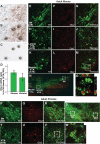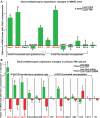The transcription factor orthodenticle homeobox 2 influences axonal projections and vulnerability of midbrain dopaminergic neurons
- PMID: 20573704
- PMCID: PMC2892944
- DOI: 10.1093/brain/awq142
The transcription factor orthodenticle homeobox 2 influences axonal projections and vulnerability of midbrain dopaminergic neurons
Abstract
Two adjacent groups of midbrain dopaminergic neurons, A9 (substantia nigra pars compacta) and A10 (ventral tegmental area), have distinct projections and exhibit differential vulnerability in Parkinson's disease. Little is known about transcription factors that influence midbrain dopaminergic subgroup phenotypes or their potential role in disease. Here, we demonstrate elevated expression of the transcription factor orthodenticle homeobox 2 in A10 dopaminergic neurons of embryonic and adult mouse, primate and human midbrain. Overexpression of orthodenticle homeobox 2 using lentivirus increased levels of known A10 elevated genes, including neuropilin 1, neuropilin 2, slit2 and adenylyl cyclase-activating peptide in both MN9D cells and ventral mesencephalic cultures, whereas knockdown of endogenous orthodenticle homeobox 2 levels via short hairpin RNA reduced expression of these genes in ventral mesencephalic cultures. Lack of orthodenticle homeobox 2 in the ventral mesencephalon of orthodenticle homeobox 2 conditional knockout mice caused a reduction of midbrain dopaminergic neurons and selective loss of A10 dopaminergic projections. Orthodenticle homeobox 2 overexpression protected dopaminergic neurons in ventral mesencephalic cultures from Parkinson's disease-relevant toxin, 1-methyl-4-phenylpyridinium, whereas downregulation of orthodenticle homeobox 2 using short hairpin RNA increased their susceptibility. These results show that orthodenticle homeobox 2 is important for establishing subgroup phenotypes of post-mitotic midbrain dopaminergic neurons and may alter neuronal vulnerability.
Figures





References
-
- Alberi L, Sgado P, Simon HH. Engrailed genes are cell-autonomously required to prevent apoptosis in mesencephalic dopaminergic neurons. Development. 2004;131:3229–36. - PubMed
-
- Ang SL. Transcriptional control of midbrain dopaminergic neuron development. Development. 2006;133:3499–506. - PubMed
-
- Arimura A. Pituitary adenylate cyclase activating polypeptide (PACAP): discovery and current status of research. Regul Pept. 1992;37:287–303. - PubMed
-
- Arimura A. Perspectives on pituitary adenylate cyclase activating polypeptide (PACAP) in the neuroendocrine, endocrine, and nervous systems. Jpn J Physiol. 1998;48:301–31. - PubMed
-
- Borgkvist A, Puelles E, Carta M, Acampora D, Ang SL, Wurst W, et al. Altered dopaminergic innervation and amphetamine response in adult Otx2 conditional mutant mice. Mol Cell Neurosci. 2006;31:293–302. - PubMed
Publication types
MeSH terms
Substances
Grants and funding
LinkOut - more resources
Full Text Sources
Other Literature Sources
Molecular Biology Databases
Research Materials
Miscellaneous

